
Welsh Family History Archive
Images of Wales
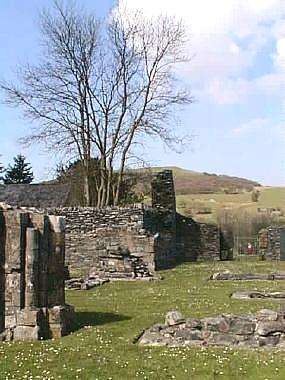
Strata Florida Abbey
Pontrhydfendigaid, Cardiganshire
Except where otherwise indicated, photography by John Ball - 30 April 1999
(with Agfa ePhoto307 digital camera)
Strata Florida Abbey (left) stands on a flat strip of meadowland on the south bank of the River Teifi near the village of Pontrhydfendigaid. The abbey was founded circa 1164 for Cistercian monks, but was destroyed by Edward I who later rebuilt it. The abbey was occupied by the troops of Henry IV, and finally dissolved as a monastery by Henry VIII. In its medieval hey-day, the abbey became not just an important religious house, but an influential centre of Welsh culture, patronised by princes and poets. The abbey is now in the care of CADW Welsh Historic Monuments.
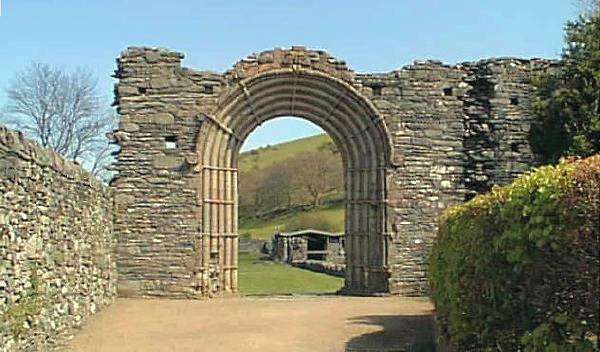
Above: The superbly carved west doorway.
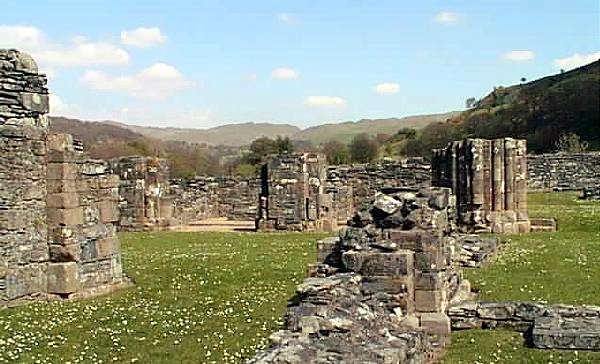
Above: Only the bases of the abbey's magnificent columns and walls have
survived the centuries.
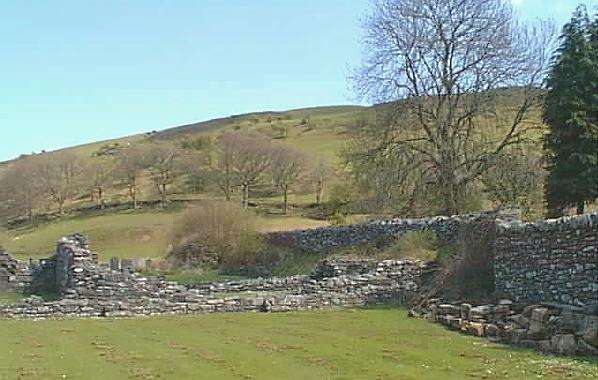
Above: The Cistercian monks chose this site for its remoteness. It is still one of the
most sparsely populated areas of Wales.
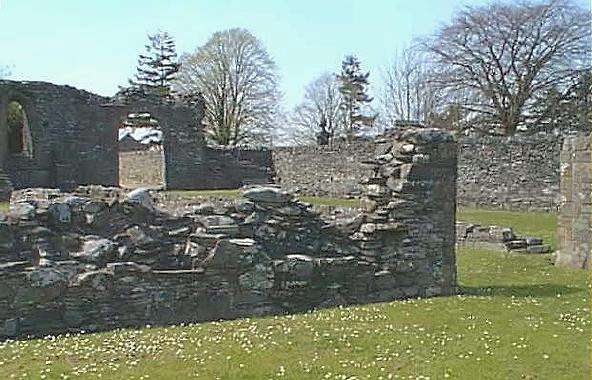
Above: Looking towards the west doorway. The name Strata Florida is a Latinised
rendering of the Welsh Ystrad fflur - the plain of the flowers.
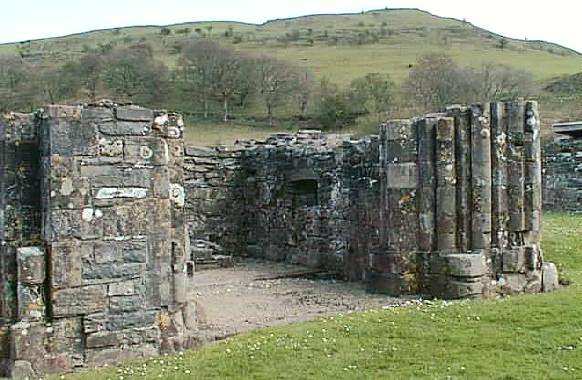
Above: All that remains of one of the many chapels in the abbey.
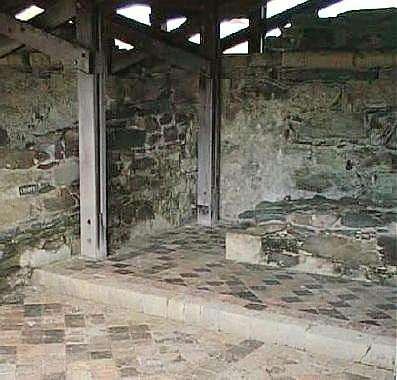
Left: Some of the chapels have been roofed over to protect the medieval floor tiles (see below).
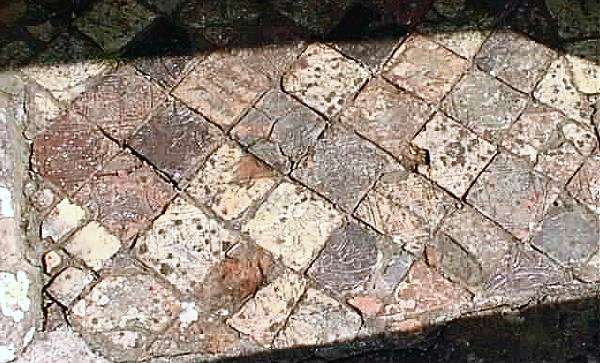
Above: Part of the original colourful floor tiling in one of the chapels. The tile pavements
are said to be the finest surviving examples in any ruined abbey in Britain.

Above: Under an ancient yew tree in the churchyard adjacent to the abbey is the burial
site of Dafydd ap Gwilym (1320 - 1380), generally regarded as the greatest Welsh poet
of all time. The main theme of his poems is love, and many of his love poems are
addressed to a lady called Morfudd.
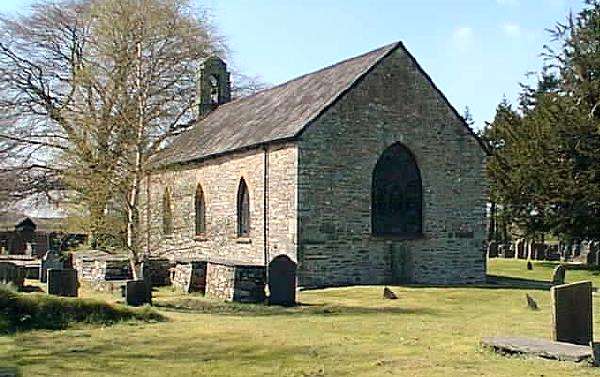 Above: St Mary's Church and graveyard in which Dafydd ap Gwilym is buried.
Above: St Mary's Church and graveyard in which Dafydd ap Gwilym is buried.
The yew tree is on the far right of the picture.
Update - 12 April 2002
The 700-year-old yew tree, which marks Dafydd ap Gwilym's burial site, recently suffered severe damage during winter storms. The main trunk split into two, sending one half of the tree crashing to the ground. A tree surgeon has been engaged to minimise the effects of the damage and (hopefully) secure the survival of the remaining healthy section of this historic tree. |
|---|
Epilogue
As well as being the burial site of Dafydd ap Gwilym, Strata Florida churchyard holds other fascinations. A local character in the nearby village of Pontrhydfendigaid told me this strange tale.
Many years ago, before the days of anaesthetics and antiseptics, a local man had to have his leg amputated to save his life. He survived the surgery and asked that his amputated leg be buried in the churchyard, in the plot which he himself would occupy when he died. The clergyman agreed to his request.
Years later, the man emigrated to America, leaving his leg behind. According to my informant, the leg is still buried in the graveyard, and is marked with a tombstone. However, I was unable to find the marker, and am left wondering whether the tale is actually true.
Nevertheless, I thought it a story well worth repeating!!
Update - 12 April 2002
In June 1999, after reading the above epilogue on my website, my good friend and fellow genealogist Julie Preston sent me the following message from her home in Michigan, USA: |
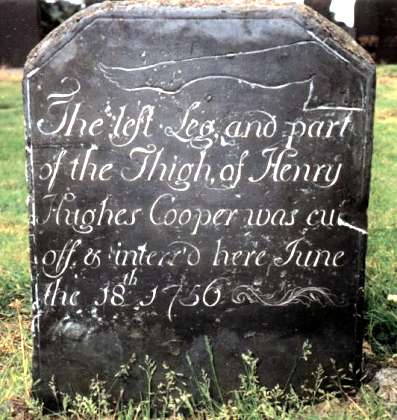
Photography by Julie Preston - July 1993 |
| |
I found the grave myself in July '93, without ever hearing the tale — plus, I have quite a good photo of it (right). The slate headstone is located very near the walls of the church, as I recall. Above the epitaph, there's a carved rendering of a well-formed leg and foot, ending just above the knee. The epitaph reads:
The left Leg, and part
of the Thigh, of Henry
Hughes Cooper was cut
off & interr'd here June
the 18th, 1756.
I found it absolutely hilarious! |
How did she do it?
The inscription on the Henry Hughes tombstone is actually very indistinct and difficult to photograph. To achieve the superb result shown above, Julie applied shaving foam to the surface of the tombstone! She explains her method thus:
Now, don't laugh, as I've introduced this method to many people and they're astounded at how well it works, even on extremely worn stones. You will need: Shaving foam (spray can); Roll of paper towels; Camera.
Spray a large dollop of shaving foam into the palm of your hand, then spread it across the engraved letters/symbols on the face of the gravestone — repeat (quickly) until all letters have been filled with the shaving foam. Use a paper towel and wipe diagonally across the stone so that the shaving foam only fills the letters themselves. Photograph immediately! The shaving foam quickly dissipates in the air and allows you to see every letter as if it had just been engraved. Slate headstones are the best for this method, as the unengraved parts appear very black and the letters show up very white as if it was a brand-new headstone. No harm done to the lichen or moss and you come home with excellent photos of the engraving.
|
Cautionary note
Conservationists may be unhappy about the application of shaving foam (or any other chemicals) to the surface of a tombstone, because such action may accelerate the erosion of the stone as well as endanger living organisms (e.g. lichen) growing on its surface. In view of this, if shaving foam is used, it is advisable to wash it off the surface with clean water immediately afterwards.
Acknowledgement
Many thanks to Julie Preston for allowing me to use her photograph and for sharing the secrets of her technique.
|











